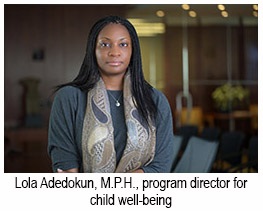 Child maltreatment can take many forms beyond physical and verbal abuse. Neglect, in fact, is the leading cause of child maltreatment and is often a result of life challenges exacerbated by poverty, including family instability; substandard housing or homelessness; exposure to neighborhood violence; inadequate educational and developmental opportunities; substandard health care; and parental substance abuse. In order to prevent child maltreatment and promote well-being among our youngest children, it is imperative that we begin to address the systemic factors that result in poor child outcomes—beyond the parent-child interaction.
Child maltreatment can take many forms beyond physical and verbal abuse. Neglect, in fact, is the leading cause of child maltreatment and is often a result of life challenges exacerbated by poverty, including family instability; substandard housing or homelessness; exposure to neighborhood violence; inadequate educational and developmental opportunities; substandard health care; and parental substance abuse. In order to prevent child maltreatment and promote well-being among our youngest children, it is imperative that we begin to address the systemic factors that result in poor child outcomes—beyond the parent-child interaction.
In recognition of this, in early 2013, the Doris Duke Foundation announced an expansion in its grant making from focusing solely on child abuse prevention to investing in the promotive efforts that influence overall child well-being. (See “A New Vision for the Child Abuse Prevention Program.”) To best achieve this shift in goals, the foundation’s renamed Child Well-being Program has moved beyond an approach that centers on the child-parent relationship to also include the whole family, surrounding community and the social service systems within which they interact. Moreover, in 2014, we refined the program strategy to incorporate an additional emphasis on three particularly vulnerable and often overlapping populations: Native American/Alaska Native communities, youth in or transitioning out of foster care, and low-income families.
Why these three populations? In short, in an era of increasing inequality, research shows that children and families in these populations are the most likely to experience negative outcomes. In 2014, Black, Latino and Native American/Alaska Native children were disproportionately represented among the 47 percent of all children under the age of three in the United States living in low-income families. Moreover, based on 2013 data, Black, Native American and Alaska Native children experienced higher rates of reported maltreatment than all other children. Although only two percent of the U.S. population identifies as Native American or Alaska Native, research showed that 40 percent of these populations were younger than 24 years old and more than a third lived in poverty. They suffered from higher rates of unemployment, substance abuse, and physical and sexual abuse. Further, they were two and a half to three times as likely to be placed in foster care, and once in foster care, they stayed longer and were less likely to return home or be adopted than white children.
In 2013, more than 400,000 children were in foster care, and 32 percent of these children were younger than six years old. During this same year, almost 25,000 youth aged out of the foster care system, most of whom were without the social supports or resources from which their more privileged peers benefitted. According to the only national study of youth aging out of foster care, 38 percent had emotional problems, 50 percent had used illegal drugs and 25 percent were involved with the legal system.
Despite the fact that these groups experience higher rates of maltreatment and poor outcomes, many interventions and programs exist that can permanently lift families out of the cycle of abuse, neglect and poverty. By investing in place-based initiatives that target some of the most neglected neighborhoods and communities around the country, the DDF Child Well-being Program is supporting approaches that coordinate data, practitioners, interventions, programs and policymakers to improve outcomes for the children and families who live there.
Additionally, we are focused on funding efforts that build capacity and share knowledge. Much has been learned in the past 30 years about ways we can ensure that all children flourish and thrive. Unfortunately, that knowledge often remains in the hands of researchers or practitioners and does not reach the eyes or ears of the policymakers and decision-makers positioned to act on it at a larger scale. There is a need to recognize and support leaders at the community, city, state and federal levels who are prepared to implement strategies drawing on the evidence that currently exists. We aim to invest in a diverse cadre of new leaders, relevant research that fills these knowledge gaps, as well as the translation of research evidence for policymakers to make more informed decisions around more effective policies and programs targeted towards children and families.
In the words of Jane Adams, a pioneer for public health reform and social work, “the good we secure for ourselves is precarious and uncertain until it is secured for all of us and incorporated into our common life.” With this aim in mind, the Child Well-being Program has taken a broader public health approach that includes an emphasis on prevention. We aim to seed actions that enrich the lives of all children. It is our hope that our grant making going forward will effectively target the programs, people and systems best situated to lead the charge in improving outcomes for the most vulnerable children and families in the U.S.
Achieving our goals will require continued investment and meaningful partnerships with researchers, funders and government leaders. Most importantly, it will require time. We are committed to updating the broader field on our progress on efforts that instill hope in our communities and support the next generation of change makers, community leaders, parents and policymakers who will hold the responsibility for ensuring that future generations prosper.